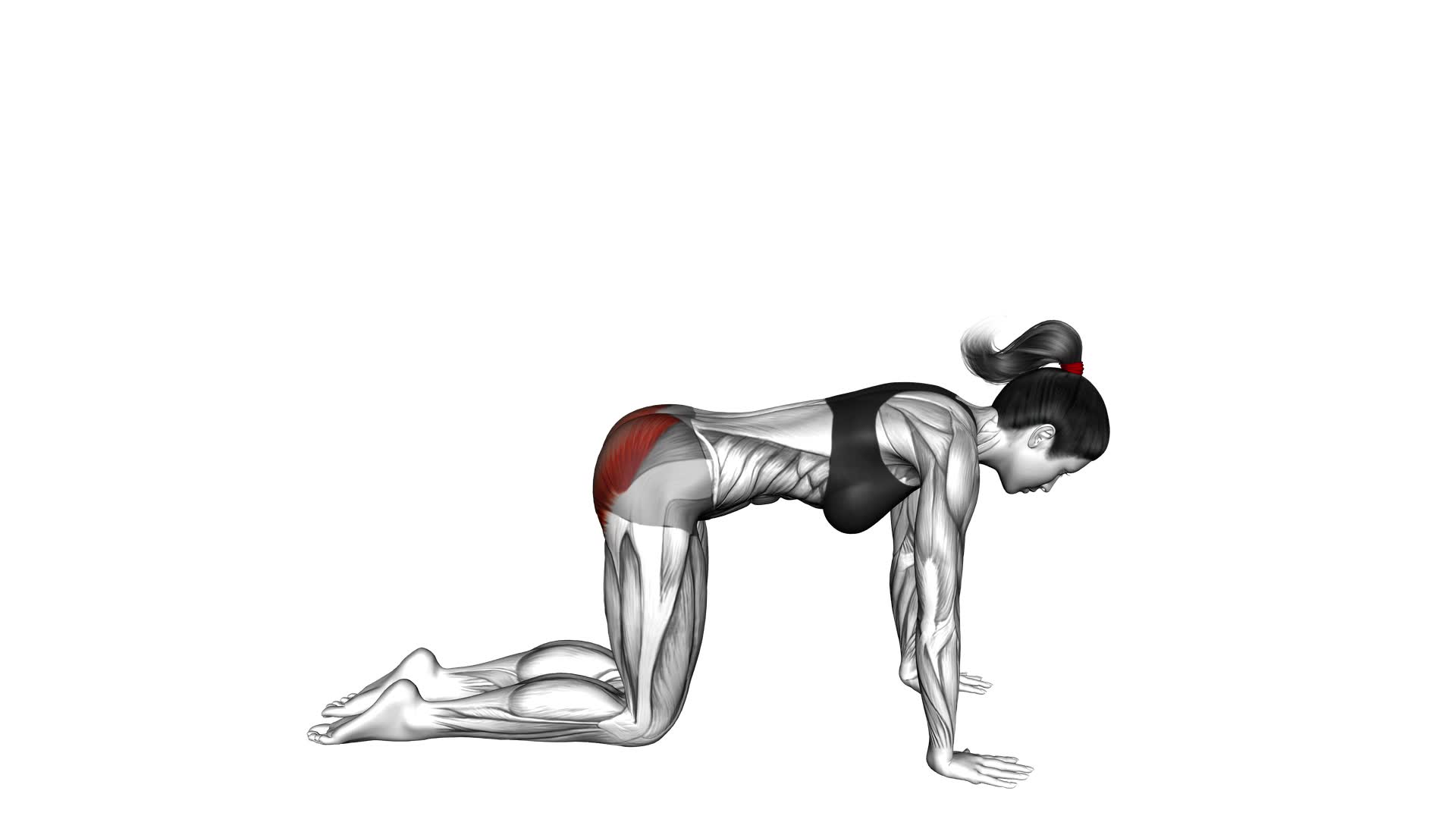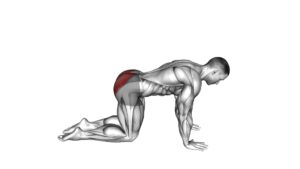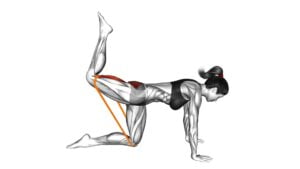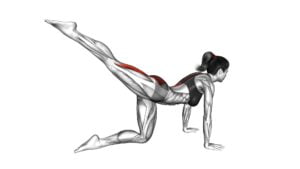Bent Leg Kickback (kneeling) – Video Exercise Guide & Tips

Get ready to strengthen and tone your glutes with the Bent Leg Kickback!
Watch This Exercise Video
This video exercise guide will show you the proper form and technique for this effective move.
You'll learn how to avoid common mistakes and discover variations to challenge yourself.
Whether you're a beginner or advanced, incorporating the Bent Leg Kickback into your workout routine will help you achieve your fitness goals.
So grab a mat and get ready to kick it up a notch!
Key Takeaways
- The bent leg kickback is a beneficial exercise for improving glute strength and stability.
- It targets the gluteus maximus, hamstrings, and lower back muscles.
- The exercise can enhance the appearance of the buttocks and improve posture and stability.
- The bent leg kickback also increases hip mobility and flexibility.
Benefits of the Bent Leg Kickback
You will experience significant improvements in glute strength and stability through regular practice of the Bent Leg Kickback exercise. This exercise specifically targets your gluteus maximus, the largest muscle in your buttocks, helping to tone and strengthen it. The Bent Leg Kickback also engages your hamstrings and lower back muscles, providing a full lower body workout.
One of the key benefits of the Bent Leg Kickback is its ability to activate and strengthen your glutes. Strong glutes not only enhance the appearance of your buttocks, but also play a crucial role in supporting your hips and lower back, improving your overall posture and stability. Additionally, this exercise helps to improve hip mobility and flexibility, which can contribute to better athletic performance and reduce the risk of injuries.
There are several variations of the Bent Leg Kickback that you can incorporate into your workout routine. You can perform the exercise while standing, lying down, or using resistance bands or ankle weights to increase the intensity. Each variation provides unique benefits and challenges, allowing you to continually progress and improve your glute strength and stability.
Now that you understand the benefits of the Bent Leg Kickback, let's discuss the equipment needed to perform this exercise.
Equipment Needed for the Exercise
To perform the bent leg kickback exercise, you'll need some essential equipment. This includes a mat or cushion for knee support, and ankle weights or resistance bands to add resistance to the movement.
However, if you don't have these items, there are alternative options you can use. For knee support, you can use a towel or a pillow to provide cushioning. As for resistance, you can get creative and use household items like water bottles or cans as makeshift weights.
Essential Equipment for Exercise
Having the right equipment is crucial for an effective workout. When it comes to exercise, there are plenty of options available that are perfect for small spaces and won't break the bank. Here are three essential pieces of equipment that you should consider:
- Resistance bands: These versatile bands are compact and can be used for a variety of exercises, targeting different muscle groups. They're perfect for small spaces and can provide an effective full-body workout.
- Yoga mat: A good quality yoga mat is essential for any exercise routine. It provides cushioning and support for your joints and prevents slipping during floor exercises. Plus, it's easy to roll up and store when not in use.
- Jump rope: Jumping rope is a great cardio exercise that can be done anywhere, including small spaces. It improves coordination, burns calories, and strengthens your legs and core. Plus, it's an affordable option for at-home exercise equipment.
Investing in these essential pieces of equipment will help you create a well-rounded workout routine in the comfort of your own home.
Alternatives to Traditional Equipment
When it comes to the Bent Leg Kickback (kneeling) exercise, alternative equipment options can be explored to achieve similar results without traditional equipment. If you don't have access to resistance bands or ankle weights, there are still alternative exercises you can do to target your glutes and hamstrings.
One option is the kneeling donkey kick, where you get on all fours and extend one leg straight back, focusing on squeezing your glutes at the top of the movement. Another alternative is the kneeling fire hydrant, where you lift one leg out to the side, keeping your knee bent at a 90-degree angle. These alternative exercises provide a creative workout idea to engage the same muscle groups without relying on traditional equipment.
Now, let's explore how you can improvise with household items to perform the Bent Leg Kickback exercise.
Improvising With Household Items
You can improvise with household items to perform the Bent Leg Kickback exercise. Don't worry if you don't have traditional workout equipment at home, because there are creative exercise substitutions you can make using items you already have.
Here are three improvised workout equipment options you can use for the Bent Leg Kickback exercise:
- A sturdy chair: Place your hands on the seat of the chair and position yourself in a kneeling position. Use the chair as support while you perform the kickback movement.
- A resistance band: Wrap the resistance band around your ankle and hold onto a stable object, such as a doorknob or a heavy piece of furniture. The band will provide resistance as you kick your leg back.
- A water bottle: Fill a water bottle with sand or another heavy material to create a makeshift weight. Hold the water bottle behind your knee as you perform the kickback exercise.
With these creative exercise substitutions, you can still get a great workout using household items. So, no excuses – get moving!
Proper Form and Technique for the Bent Leg Kickback
To execute the Bent Leg Kickback properly, hinge at the hips and extend your leg backward while maintaining a kneeling position. This exercise targets the glutes and hamstrings, and it's important to perform it with proper form and technique to maximize its effectiveness and prevent injuries.
To ensure injury prevention, start by engaging your core and maintaining a neutral spine throughout the movement. Keep your shoulders relaxed and avoid any excessive arching or rounding of the back. It's also important to avoid jerking or swinging the leg, as this can strain the muscles and lead to injury.
To add variations and progressions to the Bent Leg Kickback, you can incorporate resistance bands or ankle weights to increase the intensity. Another option is to perform the exercise on an unstable surface such as a stability ball or a BOSU ball, which challenges your balance and engages more muscles.
Transitioning into the next section about common mistakes to avoid while performing the exercise, it's crucial to be aware of these errors to ensure safety and effectiveness.
Common Mistakes to Avoid While Performing the Exercise
When performing the Bent Leg Kickback exercise, it's important to be aware of common mistakes that can hinder your progress and potentially lead to injury.
One common mistake to avoid isn't maintaining proper form throughout the movement. It's essential to keep your core engaged, shoulders relaxed, and hips stable to maximize the effectiveness of the exercise and prevent strain on your lower back.
Additionally, be cautious not to rush through the exercise, as this can compromise your technique and increase the risk of injury.
Proper Form Demonstration
To perform the Bent Leg Kickback (kneeling) exercise with proper form, focus on maintaining a straight back and engaging your glutes throughout the movement. Here are three key points to keep in mind:
- Balance is crucial: Make sure to distribute your weight evenly between your supporting knee and your hands. This will help you stay stable and prevent any wobbling or tipping over.
- Engage your glutes: Throughout the exercise, consciously squeeze your glute muscles to increase their strength. This won't only enhance the effectiveness of the exercise but also help improve your overall glute strength.
- Control the movement: Avoid swinging your leg up and down. Instead, focus on a slow and controlled motion, lifting your leg up until it's parallel to the floor and then lowering it back down with control.
Injury Prevention Techniques
Avoiding common mistakes is essential for preventing injuries while performing the Bent Leg Kickback (kneeling) exercise. To minimize the risk of injury, it's important to follow proper injury prevention techniques and incorporate effective warm-up exercises into your routine.
Before starting the exercise, ensure that your body is adequately warmed up through activities such as jogging, cycling, or dynamic stretching. This will increase blood flow to the muscles, improve flexibility, and reduce the chances of straining or pulling a muscle during the exercise.
Additionally, maintaining proper form throughout the exercise is crucial. Avoid arching your back or rounding your shoulders, as this can put unnecessary stress on your spine and increase the risk of injury.
By incorporating these injury prevention techniques, you can safely perform the Bent Leg Kickback (kneeling) exercise and minimize the risk of injury.
Now, let's move on to discussing the variations and progressions of the bent leg kickback.
Variations and Progressions of the Bent Leg Kickback
As you progress in your bent leg kickback exercise, you can explore different variations and progressions to challenge your muscles further. Here are three variations and progressions to consider:
- Resistance Band Kickback: Attach a resistance band around your ankle and secure the other end to a stable object. As you perform the kickback, the resistance from the band will provide an additional challenge to your glutes and hamstrings.
- Elevated Bent Leg Kickback: Place a step or bench behind you and rest your hands on it for support. Elevating your leg during the kickback increases the range of motion and intensifies the exercise.
- Single-Leg Bent Leg Kickback: Instead of performing the kickback with both legs simultaneously, try doing it with one leg at a time. This variation targets each leg individually, allowing for a greater focus on muscle activation and balance.
Remember to start with the basic bent leg kickback before incorporating these variations and progressions. As you become more comfortable and stronger, gradually introduce these modifications to add variety and challenge to your workout routine.
Always listen to your body and adjust the difficulty level as needed.
Tips for Incorporating the Bent Leg Kickback Into Your Workout Routine
When incorporating the bent leg kickback into your workout routine, make sure to start with proper form and gradually increase the difficulty level over time. This exercise is great for improving glute activation and can be made more challenging by incorporating resistance bands.
To begin, start by getting onto all fours with your hands directly under your shoulders and your knees under your hips. Keep your back straight and engage your core throughout the movement. From this position, bend one leg at a 90-degree angle and lift it up behind you, keeping your foot flexed. Your thigh should be parallel to the ground.
To further engage your glutes, you can add resistance bands. Simply place a resistance band around your thighs, just above your knees. This will provide extra tension and make the exercise more challenging.
As you perform the bent leg kickback, focus on squeezing your glutes at the top of the movement. This will help to maximize glute activation and ensure you're getting the most out of the exercise. Start with a lighter resistance band and gradually increase the tension as you get stronger.
Incorporating the bent leg kickback into your workout routine is a great way to target and strengthen your glutes. By starting with proper form and gradually increasing the difficulty level over time, you can maximize your results and improve glute activation.
Frequently Asked Questions
How Many Sets and Reps Should I Do for the Bent Leg Kickback Exercise?
For optimal sets and reps of the bent leg kickback exercise, it's recommended to start with 3 sets of 10 reps on each leg. This will help target your glutes and hamstrings effectively.
However, you can adjust the number of sets and reps based on your fitness level and goals. Remember to maintain proper form throughout the exercise.
If you're looking for variations or modifications, consult a fitness professional for personalized guidance.
Can I Do the Bent Leg Kickback Exercise Without Any Equipment?
You can definitely do the bent leg kickback exercise without any equipment. It's a great exercise to do at home.
To modify it for beginners, start by kneeling on all fours and then extend one leg back while keeping it bent. Focus on squeezing your glutes as you lift and lower your leg.
This exercise targets your glute muscles and can help strengthen and tone your lower body.
What Muscles Does the Bent Leg Kickback Exercise Target?
The bent leg kickback exercise targets several key muscles in your body.
It primarily works the glutes, which are responsible for hip extension and stability.
Additionally, it engages the hamstrings, which help with knee flexion and hip extension.
This exercise also activates the core muscles to maintain balance and stability.
Can I Perform the Bent Leg Kickback Exercise if I Have Knee Pain?
If you have knee pain, it may not be advisable to perform the bent leg kickback exercise. However, there are alternative exercises and modifications that can help you work similar muscles without aggravating your knees.
It's important to listen to your body and consult with a healthcare professional or a certified trainer who can provide you with proper guidance and suggest exercises that are suitable for your condition.
Is the Bent Leg Kickback Exercise Suitable for Beginners or Is It More Advanced?
For beginners, modifications can be made to the bent leg kickback exercise to make it more manageable. You can start by using a lighter weight or no weight at all, and focus on proper form and control. As you become more comfortable, you can gradually increase the weight and intensity of the exercise.
Advanced individuals can progress by using heavier weights or resistance bands, and incorporating variations like single-leg kickbacks or pulsing movements. Remember to always listen to your body and work at your own pace.
Conclusion
Incorporating the bent leg kickback into your workout routine can provide numerous benefits. It can strengthen your glutes and improve hip stability. Remember to use proper form and technique to maximize the effectiveness of the exercise and avoid common mistakes.
Additionally, you can vary the exercise by adding resistance or incorporating other movements to challenge yourself further. By consistently incorporating the bent leg kickback into your routine, you can enhance your lower body strength and overall fitness.

Author
Years ago, the spark of my life’s passion ignited in my mind the moment I stepped into the local gym for the first time. The inaugural bead of perspiration, the initial endeavor, the very first surge of endorphins, and a sense of pride that washed over me post-workout marked the beginning of my deep-seated interest in strength sports, fitness, and sports nutrition. This very curiosity blossomed rapidly into a profound fascination, propelling me to earn a Master’s degree in Physical Education from the Academy of Physical Education in Krakow, followed by a Sports Manager diploma from the Jagiellonian University. My journey of growth led me to gain more specialized qualifications, such as being a certified personal trainer with a focus on sports dietetics, a lifeguard, and an instructor for wellness and corrective gymnastics. Theoretical knowledge paired seamlessly with practical experience, reinforcing my belief that the transformation of individuals under my guidance was also a reflection of my personal growth. This belief holds true even today. Each day, I strive to push the boundaries and explore new realms. These realms gently elevate me to greater heights. The unique combination of passion for my field and the continuous quest for growth fuels my drive to break new ground.







